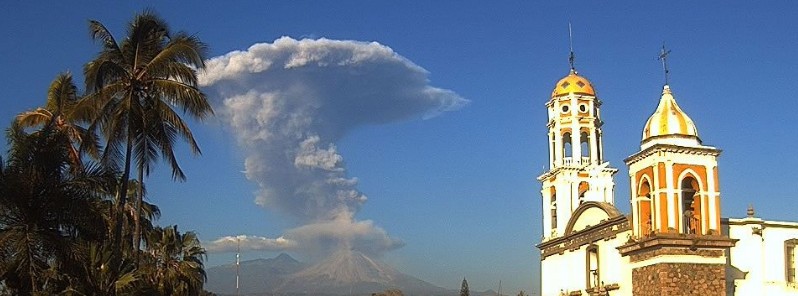Impressive eruption at Mexico’s Colima volcano

A large and impressive explosion occurred at Mexico's Colima volcano on Friday, February 3, 2017, producing an ash column that eventually rose up to 7.6 km (25 000 feet).
The eruption occurred at 23:35 UTC (17:35 CST) and generated pyroclastic flow on the volcano's eastern flank. It was the first such eruption at the volcano since January 25.
Espectacular!
Ayer desde el aire, explosión vulcaniana del Volcán de Colima, más de 5km de altura
Créditos @paulitomendoza
Vía @EUGENIOOPl pic.twitter.com/pbbUku6RRQ— Geól. Sergio Almazán (@chematierra) February 5, 2017



Although less intense, eruptions at the volcano continued into Saturday and Sunday, February 5.
ATENCIÓN Explosión del @Volcan_Colima en este momento. Vista @miravolcan desde Laguna de Carrizalillos: pic.twitter.com/gee8PJEw44
— Webcams de México (@webcamsdemexico) February 5, 2017
Mexican National Civil Protection System has warned the population that persistent and strong ashfall is expected and urged them to take necessary precautions and stay alert to official information. Even light ash fall can contaminate drinking water and food containers, they warned.
Geological summary
The Colima volcanic complex is the most prominent volcanic center of the western Mexican Volcanic Belt. It consists of two southward-younging volcanoes, Nevado de Colima (the 4320 m high point of the complex) on the north and the 3850-m-high historically active Volcán de Colima at the south. A group of cinder cones of late-Pleistocene age is located on the floor of the Colima graben west and east of the Colima complex. Volcán de Colima (also known as Volcán Fuego) is a youthful stratovolcano constructed within a 5-km-wide caldera, breached to the south, that has been the source of large debris avalanches.
Major slope failures have occurred repeatedly from both the Nevado and Colima cones, and have produced a thick apron of debris-avalanche deposits on three sides of the complex. Frequent historical eruptions date back to the 16th century. Occasional major explosive eruptions (most recently in 1913) have destroyed the summit and left a deep, steep-sided crater that was slowly refilled and then overtopped by lava dome growth. (GVP)
Featured image: Eruption of Colima volcano on February 3, 2017. Credit: WebcamsDeMexico

Commenting rules and guidelines
We value the thoughts and opinions of our readers and welcome healthy discussions on our website. In order to maintain a respectful and positive community, we ask that all commenters follow these rules:
We reserve the right to remove any comments that violate these rules. By commenting on our website, you agree to abide by these guidelines. Thank you for helping to create a positive and welcoming environment for all.